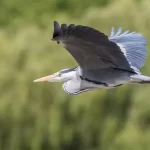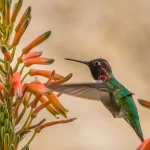By Jerry Lang
Originally Published:
Desert Rivers Audubon Magazine Spring 2024
Over 95% of North American bird species feed insects to their young.
Without insects, bird species such as warblers, vireos, and thrushes would probably vanish.
Most people are unaware of the vitally important roles insects play in ecosystems. Insects are high protein food for many animals (including migrating and breeding birds), they are also key pollinators, and nutrient recyclers. Insects comprise 80-90% of all known animal species. At any one time there are an estimated 10 quintillion insects flying, crawling, and burrowing on earth. Their total mass is estimated to be 17 times greater than all of humanity. Without the “ecosystem services” of insects, life on earth, as we know it, would not exist.
Challenges Facing Bird Species
Many bird species are facing increasing environmental headwinds against their continued existence. These factors include the interactions of habitat loss, pesticide contamination, invasive species, climate change, and loss of essential insect foods, particularly during breeding seasons. Of these factors, decreasing insect food availability has only recently caught the attention of scientists studying bird populations.

The Decline of Insect Populations
Limited studies from around the world and in many ecosystems have shown drastic decreases in insect populations and species diversity. A twenty-five year study of flying insects in German natural areas have shown insect population decreases of 75%.
Studies in the Loquillo rainforest of Puerto Rico found a 98% decrease in ground-inhabiting insects and an 80% decrease in leaf-canopy insects over the past 35-40 years.
The disappearance of birds from Australian eucalyptus forests has been blamed largely on a lack of insects due to heat and drought. Similar diminishing insect populations and diversity are reported from Mexican dry forests. Significant declines in butterfly and bee populations are also documented from Ohio, Oklahoma, and California.
Insects: A Critical Food Source for Birds
The importance of insects and other invertebrates to birds cannot be overemphasized. Over 95% of North American bird species feed insects to their young. Insects are high in protein, fats, and amino acids needed by nestlings and also by adult breeding females.
Insectivorous bird populations declined by almost 3 billion birds in the last 50 years, non-insectivorous birds have gained over 26 million. Birds consume an estimated 400 to 500 million metric tons of insects and other arthropods annually. This is as much energy as could power a city the size of New York. Although forest-dwelling/nesting birds consume about 75% of the total, birds in other habitats including savannahs, grasslands, croplands, deserts and tundra consume the rest.
Insect Dependence in Desert Birds
Desert birds such as Cactus Wrens, Verdins, Gila Woodpeckers, and even some of the smaller owl species such as Ferruginous Pygmy, Elf, and Burrowing rely on insect prey for food and for metabolic water. Aerial insectivores such as swallows and various goatsuckers are almost entirely dependent upon abundant flying insect populations. These species would probably not survive even if less aerial insects such as ants, beetles, grasshoppers were abundant.
“Insects are the little things that run the world.” – E.O. Wilson
Insectivorous bird populations declined by almost 3 billion birds in the last 50 years, non-insectivorous birds have gained over 26 million. Birds consume an estimated 400 to 500 million metric tons of insects and other arthropods annually. This is as much energy as could power a city the size of New York. Although forest-dwelling/nesting birds consume about 75% of the total, birds in other habitats including savannahs, grasslands, croplands, deserts and tundra consume the rest.

Insect Dependence in Desert Birds
Desert birds such as Cactus Wrens, Verdins, Gila Woodpeckers, and even some of the smaller owl species such as Ferruginous Pygmy, Elf, and Burrowing rely on insect prey for food and for metabolic water. Aerial insectivores such as swallows and various goatsuckers are almost entirely dependent upon abundant flying insect populations. These species would probably not survive even if less aerial insects such as ants, beetles, grasshoppers were abundant.
Caterpillars: A Preferred Prey
Birds foraging for their nestlings will choose caterpillars over other types of insect prey if they are available since, on a comparative basis, caterpillars are large and nutritious. Studies indicate that Carolina chickadees may feed nestlings 6000 – 9000 caterpillars per brood.
“Birds are indicators of the environment.
If they are in trouble, we know we’ll soon be in trouble.”
– Roger Tory Peterson
Caterpillars are an important food component for over 300 North American bird species. Without insects, bird species such as warblers, vireos, and thrushes would probably vanish. Besides the direct loss as an important food source, the loss of insect pollinators also indirectly impacts birds – particularly those that feed on fruits and nuts.
The Importance of Studying Insect Declines
Scientists have only recently started to investigate what is happening to insect populations and its possible impact on birds.
The changes being observed around the world are no doubt a result of various combinations of factors – particularly the interplay of land use changes, persistent pesticide use, climate change, and invasive species. This is the same set of issues directly confronting birds.
Agriculture and Climate Change
Intensification of agriculture and its simplification of ecosystems along with widespread use of pesticides such as neonicotinoids are known to be detrimental to insect life and directly and indirectly tOver 95% of North American bird species feed insects to their young. Without insects, bird species such as warblers, vireos, and thrushes would probably vanish.o birds.
In contrast to most agricultural systems, a study from organic livestock farming in Finland has shown a positive effect on insect populations and insectivorous birds. Dung draws the insects, rotational grazing improves plant diversity, and the lack of insecticide use characterizes this type of farming.
“What would be left of our tragedies if an insect
were to present us his?”
– Emil Cioran
Climate Change and Insect Populations
Rapidly changing and extreme weather phenomena associated climate change can result in direct death of insects and birds from heat, cold, dryness, and flooding. Climate change can also interfere with phenological timing associated with bird migration/breeding cycles, e.g. insect populations peaking prior to or after bird breeding seasons. Invasive plant species replacing native species in commercial forestry and horticulture have detrimental effects on insects that have not evolved to use the invasives as part of their life cycles.
No Birds Without Bugs
One researcher commented that insect life forms a “bottom-up” trophic cascade, i.e. insects are foundational to life on earth whether that is bird life or human life.
The real ‘bottom line’ is that there can’t be birds without bugs.








